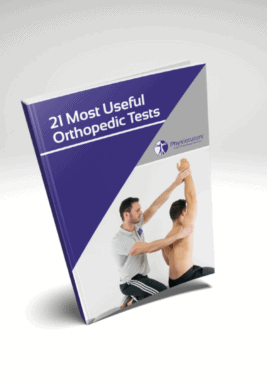Learn
Reverse Lachman Test | Posterior Cruciate Ligament Tear Assessment
The PCL provides maximum resistance to posterior tibial translation When the knee is at 90° of flexion.
However, the Posterior Drawer Test can be difficult to perform in the acutely injured knee because the patient experiences discomfort during knee flexion.
In those situations, the Reverse Lachman Test may be useful. According to Rubinstein et al. (1994), The Reverse Lachman Test has a Sensitivity of 63% and a Specificity of 89%.
For this reason, it has a moderate clinical value to confirm a PCL Tear, although we have found only one study to evaluate its validity yet.
To perform the Reverse Lachman Test have your patient in supine line position with the knee flexed to 30°. You can stabilize this position by placing your knee under it.
Then place your contralateral hand on the femur from lateral and the ipsilateral hand on the Tibia from medial like in a normal Lachman test. Both hands are close to the joint line as we want to translate and not angulate.
The Tibia must be anatomically reduced in the PCL deficient knee at the start of this test. Rotation is neutral to avoid the recruitment of secondary stabilizers.
Then exert a posteriorly directed force to the tibia and feel for end feel and the degrees of translation
This test is positive if the end feel Is soft or absent, all with an increased posterior translation of the tibia compared to the other side.
Lubowitz et al. (2008) described a grading for a posterior translation:
- Gade 1: 1 0-5mm and the tibial plateau remains anterior to the femoral condyle
- Grade 2: 6-10mm, which correlates with the tibial plateau being flush with the femoral condyle
- Grade 3: >10mm of translation, which allows the tibial plateau to translate posteriorly to the femoral condyle
If you notice increased translation with the Reverse Lachman test but not with the Posterior Drawer Test, an injury to the posterior lateral corner might be present.
To distinguish between a PLC and a PCL Injury, performing the Dial Test is recommended.
21 OF THE MOST USEFUL ORTHOPAEDIC TESTS IN CLINICAL PRACTICE

Other common tests to assess PCL tears are:
- Posterior Drawer Test
- Posterior Sag Sign / Godfrey’s Test / Step-Off Test
- Quadriceps Active Test / Active Drawer Test
References
Like what you’re learning?
BUY THE FULL PHYSIOTUTORS ASSESSMENT BOOK
- 600+ Pages e-Book
- Interactive Content (Direct Video Demonstration, PubMed articles)
- Statistical Values for all Special Tests from the latest research
- Available in 🇬🇧 🇩🇪 🇫🇷 🇪🇸 🇮🇹 🇵🇹 🇹🇷
- And much more!








